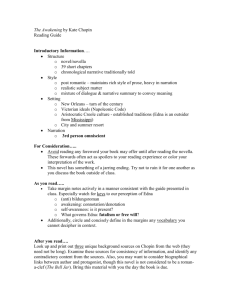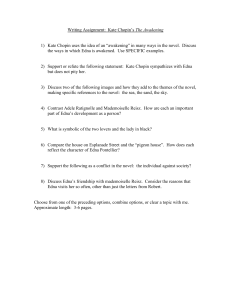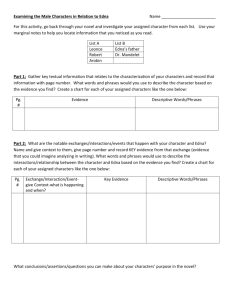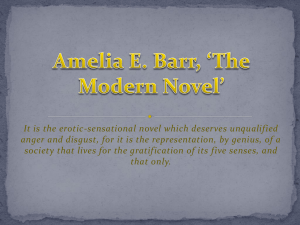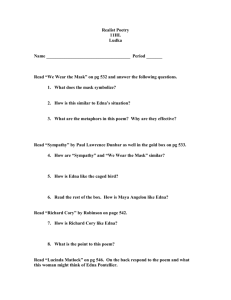Literary Movements and The Awakening
advertisement
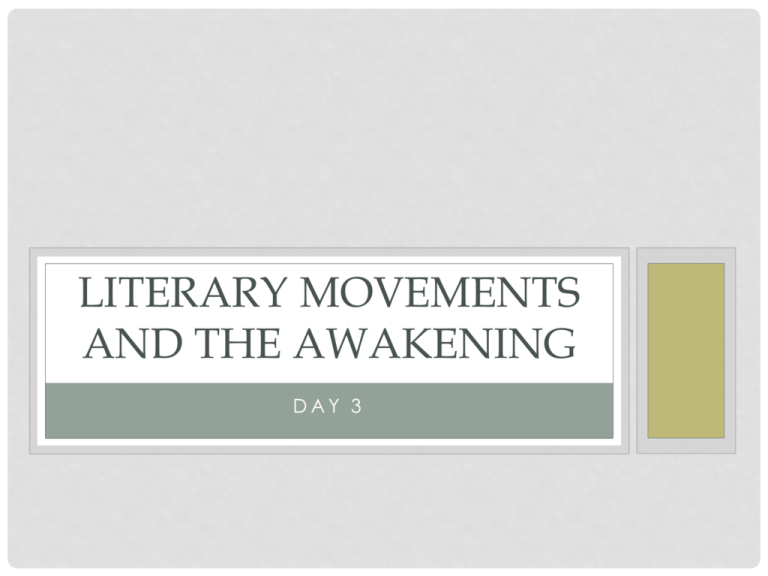
LITERARY MOVEMENTS AND THE AWAKENING DAY 3 AMERICAN ROMANTIC MOVEMENT (1800-1850’S) • Expressed the assertion of the self, the power of the individual, a sense of the infinite, and transcendental nature of the universe. • Major themes included the sublime, terror, and passion. • The writing extolled the primal power of nature and the spiritual link between nature and man, and was often emotional, marked by a sense of liberty, filled with dreamy inner contemplations, exotic settings, memories of childhood, scenes of unrequited love, and exiled heroes. • They also tended in sculpture and paintings to return to the mythological to express the primal nature of mankind. • American Realism also emphasized the conquering of lands and conquering of personal demons. • The major writers of the period were Irving, Cooper, Emerson, Poe, Thoreau, Hawthorne, Whitman, Dickinson, and Melville. SEARCH FOR SELF • Edna's search for individuality and freedom: freedom to decide what to be, how to think, and how to live. This search amounts to her own romantic quest for a holy grail, a grail of self-definition. In the process two classic motifs of the Romantic movement occur: rebellion against society and death. • “She could only realize that she herself—her present self—was in some way different from the other self. That she was seeing with different eyes and making the acquaintance of new conditions in herself that colored and changed her environment, she did not yet suspect” (XIV, 69) PRIMAL POWER OF NATURE • Perhaps the most obvious and elemental are the exotic locale, use of color, and heavy emphasis on nature. • Frequent inner thoughts, memories of childhood, the personified sea and its sensuous call, the fantastic talking birds, the mysterious woman in black, the romantic music playing almost constantly in the background, the dinner party, the gulf spirit, and the desire to express herself through art. • “She could hear again the ripple of the water, the flapping sail. She could see the glint of the moon upon the bay, and could feel the soft, gusty beating of the hot south wind. A subtle current of desire passed through the body, weakening her hold upon the brushes and making her eyes burn.” (end of XIX, 96) AMERICAN REALISM • Realism developed as a reaction against Romanticism and stressed the real over the fantastic. • The movement sought to treat the commonplace truthfully and used characters from everyday life. • Writers probed the recesses of the human mind via an exploration of the emotional landscape of characters. • Local color, an offshoot of realism, attempts to capture a community of people. • Women local colorists were concerned with the place of women in society and the moral designs called for in a life. • Freemen, Stowe, Harris, Chesnutt, and Cable were all important local colorists. THE NOVEL AND AMERICAN REALISM • The characters that Chopin places in the novel, with all their flaws and their eccentricities, also a real world to develop. It is also the physical description of the people and the landscapes attempts to give the realism that Chopin seeks when she paints Madame Ratignolle. This is seen also in her visits to the various New Orleans residences. • The description of Mademoiselle Reisz’s apartment at the opening of XXI. • Edna’s response to Madame Ratignolle about Leonce and going to the club: “It’s a pity Mr. Pontellier doesn’t stay home more in the evenings. I think you would be more—well, if you don’t mind me saying it—more united if he did.” “Oh! Dear no!” said Edna, with a blank look in her eyes, “What should I do if he stayed home? We wouldn’t have anything to say to each other” (XXIII 112) • The relationship between men and women and the economic aspects that go along with that issue are also realistic. Edna is "owned" at various points in the novel by her father, husband, Arobin, and Robert. Victor (Robert’s brother) speaks of women in terms of possession, and Leonce is shown to class her as property, and to see her as a symbol of his social status. Edna herself remarks that as she moves into the pigeon house she feels she is lower on the social rank. • In terms of local color, Chopin uses Edna’s inspection of Creole culture at Grand Isle and later in terms of the creation of her daily life in New Orleans. Here, a portrait of women’s lives develops. LOCAL COLOR OF NEW ORLEANS • “The Pontelliers possessed a very charming home on Esplanade Street in New Orleans. It was a large, double cottage, with a broad front veranda, whose round, fluted columns supported the sloping roof. The house was painted a dazzling white; the outside shutters, or jalousies, were green. In the yard, which was kept scrupulously neat, were flowers and plants of every description which flourishes in South Louisiana. Within doors the appointments were perfect after the conventional type. The softest carpets and rugs covered the floors; rich and tasteful draperies hung at doors and windows. There were paintings, selected with judgment and discrimination, upon the walls. The cut glass, the silver, the heavy damask which daily appeared upon the table were the envy of many women whose husbands were less generous than Mr. Pontellier. • “Mr. Pontellier was very fond of walking about his house examining its various appointments and details, to see that nothing was amiss. He greatly valued his possessions, chiefly because they were his, and derived genuine pleasure from contemplating a painting, a statuette, a rare lace curtain -- no matter what -- after he had bought it and placed it among his household gods.’ (Opening Chapter XVII 83/49-50) NATURALISM • Naturalism grew out of Realism and stressed the uncaring aspect of nature and the genetic, biological destiny of man. • Naturalists believed that man's instinctual, basic drives dominated their actions and could not be evaded. • Life was viewed as relentless, without a caring presence to intervene. • Twain, Crane, London, Norris, Howells, James, and Dreiser were the major writers of this movement. NATURALISM AND THE NOVEL • The aspect of naturalism most evident in The Awakening is the portrayal of Edna as hostage to her biology. • She is female, has children, and is a wife in a society that dictates behavioral norms based on those conditions. These factors drive the novel and drive Edna. • The novel is also true to the real life aspects of Realism and Naturalism in its forthright dealing with sexual matters: Leonce's allusion that they no longer sleep together, Robert’s touch of her clothes after she awakes, the naked man on the rock on Grand Isle. WOMEN’S RIGHTS AND FEMINISM • Mary Wollstonecraft (mother of Mary Shelley who wrote Frankenstein) published the Vindication of the Rights of Women during the Romantic movement. The more formalized call for the advancement of women begun. • Women in America, through the Abolition Movement, gained entranced to the political scene with the call to end slavery. • Many of these women remained politically involved and set about getting the right to vote for women in America, Elizabeth Cady Stanton, being a significant force. • This was furthered by the idea of social reforms concerning the poor, the orphaned, and the mentally ill. Charlotte Perkins Gilman and Dorothea Dix were significant figures. • By the dawn of the twentieth century, women has still not received the right to vote, but female novelists took to examine the life of women outside of societal conformity. THE NOVEL AND FEMINISM • Chopin uses Edna’s inner life as well as the portrait of the many marriages to inspect the limitations of gender. Virginia Woolf would later characterize this as a need for “a room of one’s own.” In giving up the physical world of her marriage, Edna sets about exploring the individual life. Mademoiselle Reisz also serves as the woman living outside the confines of marriage, outside the social conventions. • Leone’s discussion with the doctor—also allows Chopin to examine the societal conception that Edna’s behavior is a symptom of a disease: “she’s got some sort of notion in her head concerning the eternal rights of women” and the doctor’s reply: “Has she been associating of late with a circle of pseudointellectual women-superspiritual superior beings? My wife has been telling me about them” and Edna’s remark; “she says that a wedding is one of the most lamentable spectacles on earth. Nice thing for a woman to say to her husband” and the doctor’s assessment of women: (XXII, 107-108) • Later, Edna’s own father, the colonel lends his solution: “You are too lenient, too lenient by far, Leonce,” asserted the colonel. “Authority, coercion are what is needed. Put your foot down good and hard; the only way to manage a wife. Take my word for it.” The colonel was perhaps unaware that he had coerced his own wife into her grave” (XXIV 116)
